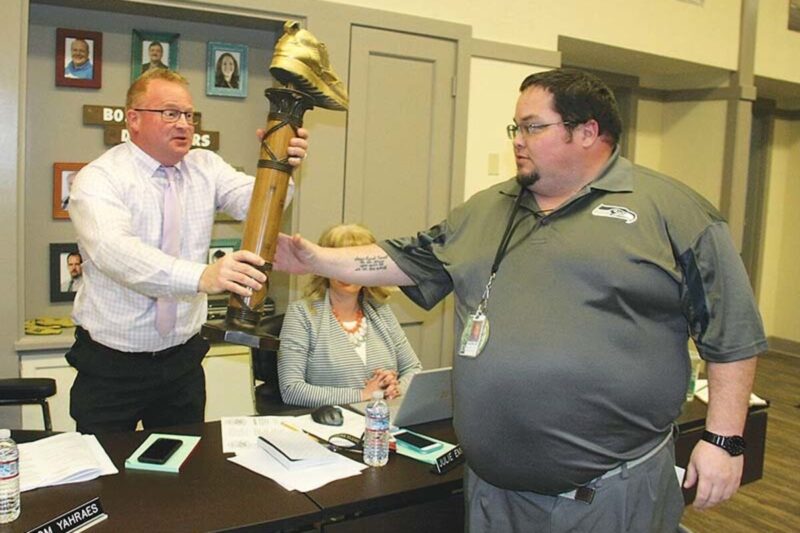Sean C. Morgan
The Sweet Home School District is doing more than ever to track down students who leave high school and ensure they are in some kind of program in which they will earn a diploma or GED.
Sweet Home High School staff members Kristin Adams and Jim Kistner gave a presentation to the School Board Monday evening, Feb. 11, outlining their efforts to reduce the dropout rate.
The district is operating over the 2017-19 biennium on some $660,000 in what have been called Measure 98 funds, which are dedicated to improving graduation rates by increasing career and technical education programs, college preparation and reducing dropout rates.
In the baseline year, 2016-17, the four-year graduation rate at SHHS was 70.88 percent. Funding became available in the 2017-18 school year. Last school year, the graduation rate was 71.26 percent, Adams told the board. The five-year completer rate is nearly 81 percent. The completer rate includes students who have earned GEDs or other completed other alternatives.
The dropout component of the Measure 98 program, the High School Success Initiative, was the part that most concerned Adams as she was developing the program.
The Class of 2017 had 41 dropouts, she said. The Class of 2018 had 27.
Kistner told the board that at this point, SHHS has just six students drop out so far this year. That number could be 18, but the district has contacted and transferred 12 of them to another placement.
Kistner said that 34 students have transferred to another public school. Thirteen have transferred to an Education Service District home school program.
Eleven students have finished graduation requirements early. Four have been placed in alternative programs or detention centers. Three have transferred to public online schools.
As of Feb. 1, the high school had 683 students enrolled.
The school has added a number of in-school programs to help keep students enrolled and on track.
Among them is a new freshman focus group dedicated to tracking whether each freshman is on track, Adams said. A new summer and winter school program, each two weeks long, has helped students recover more than 60 credits.
A team of staff members track chronic absenteeism, those who miss more than 10 percent of school days. The team works with the students to determine the reasons for their absenteeism and solve problems.
A care team, along with two part-time student advocates, tracks 10th- through 12th-graders. Students who are failing one to three classes are assigned to one of the advocates. Principal Ralph Brown gets involved with students failing four or five classes, and an advocate is likely assigned as well.
Kistner, a retired counselor working part time, is assigned to help those students who are most off track. He tracks down students who drop out without saying anything.
When students move and enroll in another district, the new district requests records; but sometimes, Sweet Home won’t receive a request for students who have left the district. That’s where Kistner swings into action.
“It’s been incredibly rewarding,” Kistner said. “The time that it takes to track down these kids, it can be very difficult sometimes. Probably one of my first cases, I probably made 12, 15 phone calls before I ever connected with them.”
He tracked down another student to North Bend, he said. The district hadn’t received a request for records, and he went to work reaching out to family members and friends to find out where the student went.
The district’s truancy officer also has been helping in the process, Adams said.
When the district finds out where the student is, Kisner said, it often works hand-in-hand with another school district “to help the student feel comfortable enough to walk through their doors.”
He connects those still in the area to various programs to help them complete high school, whether with a diploma or a GED. He meets with these students a minimum of twice a week to work on attendance, and he tries to get parents connected as well.
Some 50 students are plugged into some sort of alternative plan or program right now with the idea of graduating this year, Kistner said. Fourteen are working on their GEDs through SHHS.
“Each plan is very individualized,” Kistner said. “It is built with long-term success in mind.”
Many of these students have lacked success over time, he said, “so it’s easy for them to disengage.”
Programs like the winter and summer schools; a new after-school program; and the Odysseyware program, which allows students to learn at their own pace, have led to success for some of them, and that motivates them to catch up, he said.
The district has gotten much better at tracking down every single student, said Supt. Tom Yahraes, learning their stories and doing something to get them back into the education system.
Present at the meeting were board members Toni Petersen, Jim Gourley, Jason Van Eck, Chanz Keeney, Mike Reynolds, Chairman Jason Redick, Debra Brown and Jenny Daniels. Angela Clegg was absent.
In other business, the board received a draft of the proposed calendar for 2019-20.
The board and district personnel will review the calendar this month, and the board will consider approving it on March 11.
Under the proposed calendar, school will start on Sept. 3 and end on June 11, 2020. Graduation will be June 5, 2020.
Christmas break will begin Dec. 23. students will return to school on Jan. 6. Spring break will run from March 23 to March 27.
Parent-teacher conferences are scheduled for Oct. 24 and Oct. 25 and for April 23 and April 24. Students will have Oct. 10 and Oct. 11 off for in-service.





